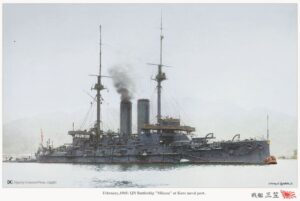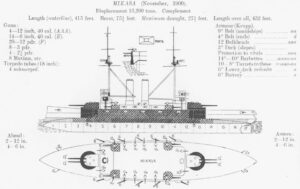 It is not usually my habit to talk about the spectacular ships built by our nation’s enemies, but IJN Mikasa might be a worthy exception. The Mikasa is a “pre-dreadnought” battleship built for the Imperial Japanese Navy (IJN) in the late 1890s and is the only ship of her class. I didn’t know what a “pre-dreadnought” ship was, so I looked into it. “Pre-dreadnoughts were battleships built before 1906, when HMS Dreadnought was launched. Dreadnoughts were more powerful battleships that followed the design of HMS Dreadnought and so made pre-dreadnoughts obsolete.” The ship displaced over 15,000 long tons, with a crew of over 800 men.
It is not usually my habit to talk about the spectacular ships built by our nation’s enemies, but IJN Mikasa might be a worthy exception. The Mikasa is a “pre-dreadnought” battleship built for the Imperial Japanese Navy (IJN) in the late 1890s and is the only ship of her class. I didn’t know what a “pre-dreadnought” ship was, so I looked into it. “Pre-dreadnoughts were battleships built before 1906, when HMS Dreadnought was launched. Dreadnoughts were more powerful battleships that followed the design of HMS Dreadnought and so made pre-dreadnoughts obsolete.” The ship displaced over 15,000 long tons, with a crew of over 800 men.
While she might not have been as powerful, IJN Mikasa was nevertheless a well-built ship, that was able to withstand more than most ships of her time. Named after Mount Mikasa in Nara, Japan, she served as the flagship of Vice Admiral Togo Heihachiro throughout the Russo-Japanese War of 1904–1905. That war included the Battle of Port Arthur, which occurred on the second day of the war, as well as the Battles of the Yellow Sea and Tsushima. Just a few days after the Russo-Japanese War ended, Mikasa’s magazine (a ship’s magazine is where the powder and shells are stored) suddenly exploded and sank the ship. The explosion killed 251 men. Shortly before the Mikasa’s fatal accident, the ship had been involved in the  Battle of Tsushima (May 27, 1905), during which she had shrugged off over 40 shell strikes from heavy Russian naval guns! In that battle 113 of her crew were killed or injured. While such an event would usually mean the end of a ship, IJN Mikasa was salvaged, and while her repairs took over two years to complete, she went on to serve as a coast-defense ship during World War I, and she supported Japanese forces during the Siberian Intervention in the Russian Civil War. Ironically, in 1912 a despondent sailor among her crew tried to blow the ship up once again while the ship was anchored at Kobe. In the end the ship served until 1923, after being pulled up from the drink, repaired, and recommissioned.
Battle of Tsushima (May 27, 1905), during which she had shrugged off over 40 shell strikes from heavy Russian naval guns! In that battle 113 of her crew were killed or injured. While such an event would usually mean the end of a ship, IJN Mikasa was salvaged, and while her repairs took over two years to complete, she went on to serve as a coast-defense ship during World War I, and she supported Japanese forces during the Siberian Intervention in the Russian Civil War. Ironically, in 1912 a despondent sailor among her crew tried to blow the ship up once again while the ship was anchored at Kobe. In the end the ship served until 1923, after being pulled up from the drink, repaired, and recommissioned.
IJN Mikasa was decommissioned on September 23, 1923, following the Washington Naval Treaty of 1922. At that time, she was scheduled for destruction, but at the request of the Japanese government, each of the signatory countries to the treaty agreed that Mikasa could be preserved as a memorial ship. The agreement required that her hull be encased in concrete. On November 12, 1926, Mikasa was opened for display in Yokosuka in the presence of Crown Prince Hirohito and Togo. Unfortunately, the ship deteriorated under the  control of the occupation forces after the surrender of Japan in 1945. Finally, in 1955, American businessman John Rubin, who had formally lived in Barrow, England, wrote a letter to the Japan Times about the state of the ship. His letter served as the catalyst for a new restoration campaign. The Japanese public, who were widely onboard with the idea, supported the project, as did Fleet Admiral Chester W Nimitz. The ship was once again restored, and the museum version reopened in 1961. On August 5, 2009, IJN Mikasa was repainted by sailors from USS Nimitz, and she is now the only surviving example of a “pre-dreadnought” battleship in the world. IJN Mikasa is located in the town of its construction, Barrow-in-Furness, near Mikasa Street on Walney Island.
control of the occupation forces after the surrender of Japan in 1945. Finally, in 1955, American businessman John Rubin, who had formally lived in Barrow, England, wrote a letter to the Japan Times about the state of the ship. His letter served as the catalyst for a new restoration campaign. The Japanese public, who were widely onboard with the idea, supported the project, as did Fleet Admiral Chester W Nimitz. The ship was once again restored, and the museum version reopened in 1961. On August 5, 2009, IJN Mikasa was repainted by sailors from USS Nimitz, and she is now the only surviving example of a “pre-dreadnought” battleship in the world. IJN Mikasa is located in the town of its construction, Barrow-in-Furness, near Mikasa Street on Walney Island.


Leave a Reply